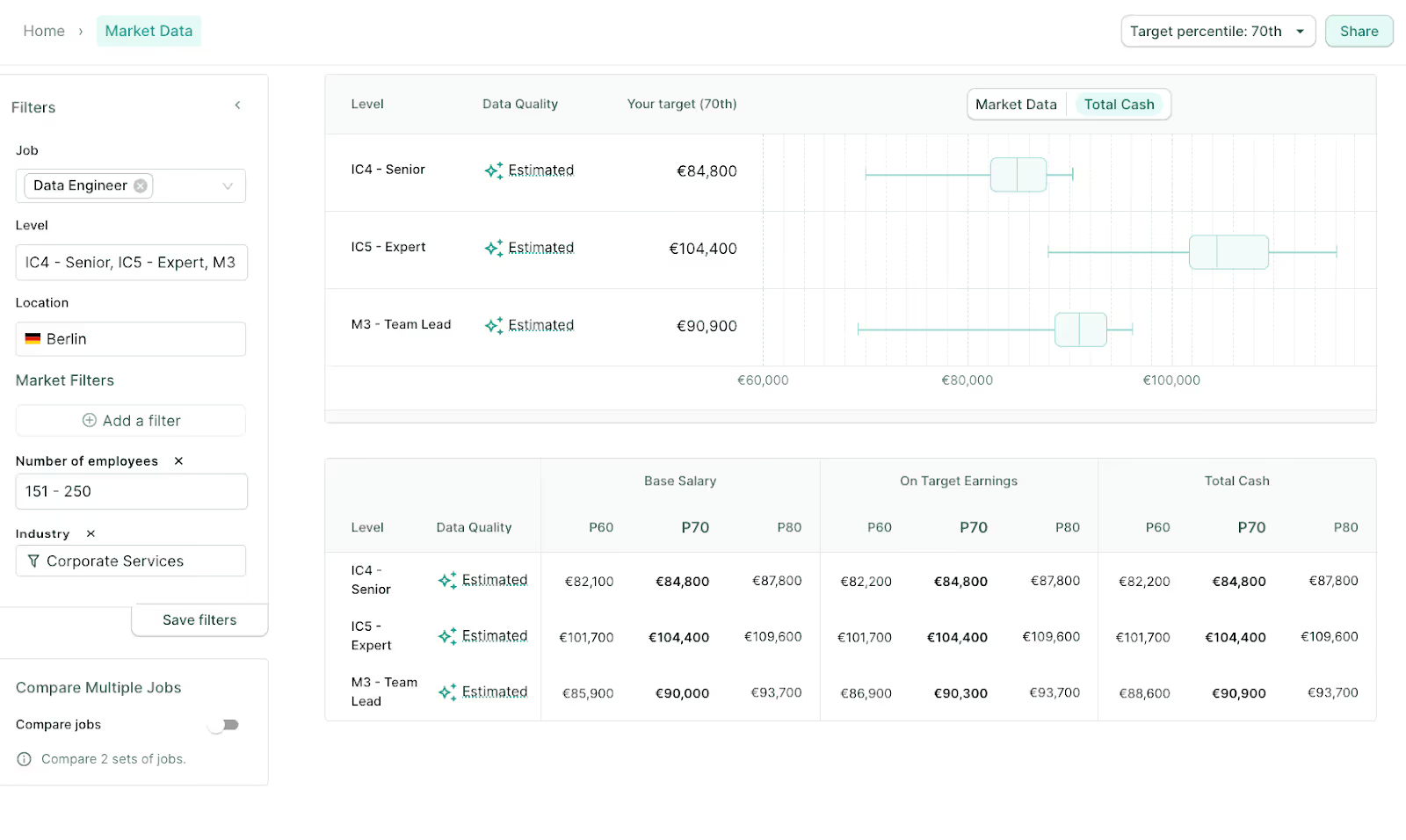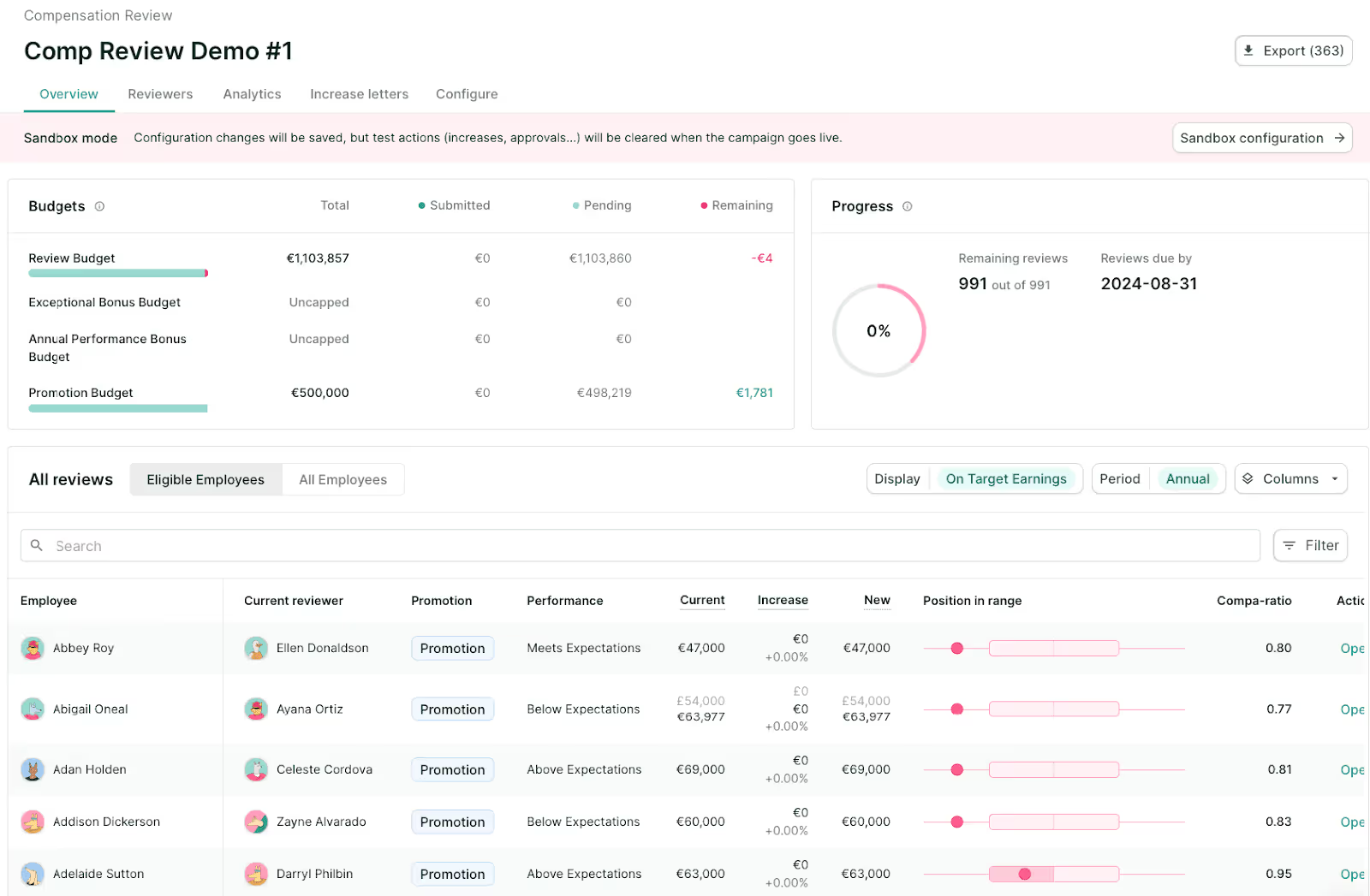Key points:
- Executive compensation directly impacts performance: Well-structured packages turn executives into growth partners, while poor design leads to talent loss and misaligned objectives.
- It's more than just salary: Effective packages blend base salary (typically 30% of total), short-term bonuses, long-term equity incentives, pensions, and benefits.
- Market data drives competitive packages: Traditional salary surveys lag 12-18 months behind reality. Real-time benchmarking ensures you're competing effectively for talent.
- One size doesn't fit all: CFOs need different incentives than CTOs. Personalise packages based on role requirements, risk profiles, and individual motivations.
- Annual reviews are the minimum: Markets shift rapidly – your competitive January package might be below market by December. Regular reviews prevent expensive talent losses.
Executive pay packages shape how leaders perform every single day. Get them right, and executives become true partners in driving growth. Get them wrong, and you'll watch your best talent walk out the door while those who stay lose focus on what matters most.
The consequences of poor design hit hard: demotivated teams, misaligned objectives, and shareholders wondering why their returns keep disappointing.
If this sounds familiar, you’re probably due for a transformation, and there’s no better time than now. In 2024, one in four of the UK's largest companies completely renewed their executive compensation approach. These forward-thinking organisations recognised a crucial truth: yesterday’s packages won’t motivate tomorrow’s leaders.
However, getting executive compensation right requires both strategic thinking and practical know-how. In this guide, we’ll explore how to design packages that compete in your market while driving the specific results your business needs.
First, let’s begin with the basics…
What is executive compensation?
Executive compensation is the total rewards package offered to senior leaders in exchange for their services. It includes all forms of payment and benefits designed to attract, retain, and motivate top-level management.
These usually include the base salary, bonuses, equity awards, pension contributions, and various perks. Each component serves a specific purpose in the overall strategy:
- The base salary provides financial stability.
- Short-term bonuses reward immediate performance.
- Long-term incentives align executives with shareholder interests.
- Benefits and perks enhance quality of life and demonstrate the company's commitment to its leaders.
So, what is the purpose of an executive compensation package?
- Attracting high-calibre talent in competitive markets.
- Motivating executives to achieve strategic objectives.
- Retaining valuable leaders who drive company growth.
Most of all, well-designed packages create accountability. They link rewards directly to performance metrics, which gives executives the extra push to focus on outcomes that matter to shareholders, employees, and other stakeholders.
Key components of effective executive compensation packages
We briefly mentioned the different puzzle pieces that make up a competitive executive package, but now it’s time to look at them in a bit more detail.
Annual base salary
The foundation of any package starts here. Deloitte found that base salaries typically account for around 30% of total compensation offered. While it might seem like a smaller slice of the pie, this guaranteed income provides executives with financial security and peace of mind.
Think of base salary as your stability anchor. It covers living expenses and creates a predictable income stream that executives can rely on, rain or shine.
Short-term bonus plans
Here’s where things get interesting! Short-term bonuses are directly tied to specific targets and KPIs, typically measured annually. These might include:
- Revenue growth targets.
- Profit margin improvements.
- Customer satisfaction scores.
- Operational efficiency metrics.
The beauty of well-structured bonuses? They create immediate accountability and keep executives focused on current priorities.
Long-term incentives (LTIPs)
Now we're talking serious motivation. Long-term incentives, particularly stock and equity awards, align executive interests with company success over the years, not just quarters. The main vehicles include:
- Stock options – Give executives the right to buy shares at a set price. If the company performs well, they profit from the difference.
- Restricted Stock Units (RSUs) – Actual shares that vest over time, ensuring executives stay invested (literally) in long-term growth.
Now, these are extremely important on an executive level – after all, you want these employees to be just as engaged in the future of the business as the actual owner of the company. If the company’s success is closely tied to its own, the efforts increase to another level.
Benefits and perks
The finishing touches that make packages shine:
- Private health insurance for the whole family.
- Company vehicles or car allowances.
- Gym memberships and wellness programmes.
- Executive coaching and development opportunities.
Pension contributions
Often overlooked but incredibly valuable, pension contributions demonstrate commitment to executives' long-term financial wellbeing. This is the perk that says: “We’re with you till the end!”
Smart companies use generous pension schemes to differentiate themselves from competitors who focus solely on immediate rewards.
💡 Remember: competitive packages blend all these elements strategically. The mix depends on your company’s goals, culture, and the specific executive role you’re filling.
How to design competitive packages
Now comes the exciting part – turning theory into practice. You understand the components, but how do you blend them into packages that actually work?
Think of this as your recipe for success. Just as a master chef combines ingredients with precision and flair, you’ll learn to mix compensation elements that satisfy everyone at the table: executives hungry for opportunity, boards watching the bottom line, and employees expecting fairness.
Let’s start with the most critical ingredient for our compensation soup: alignment.
Align compensation structures with company goals
Start by asking yourself: what behaviours do you want to encourage? Your compensation structure should make executives natural champions of your company strategy.
Here’s how to create that alignment:
Map each compensation element to specific company objectives. For example, if international expansion is your priority, tie bonuses to new market penetration. But if you’re focusing on digital transformation, it makes more sense to link long-term incentives to technology adoption metrics.
Whatever you choose, make sure to involve all stakeholders early and often. This means:
- Board members who understand governance requirements.
- Current executives who know what motivates their peers.
- HR teams who'll implement the structure.
- Even key investors who care about sustainable growth.
The magic happens when everyone agrees on what success looks like. Take Swan, the European fintech company providing Banking-as-a-Service. When they implemented Figures' compensation review module, they transformed their approach entirely.
As Mathilde Sou, HRBP at Swan, explains: "Implementing a tool to manage our salary reviews forced us to structure our campaign much more precisely."
The result? They achieved 100% of employees positioned within their internal salary bands, with compensation decisions aligned to both market data and organizational structure.
Your compensation structure should tell a story about where your company is heading. Make that story compelling, and executives will write the chapters themselves.
Balance your compensation mix
Once you understand the components, it's time to make strategic decisions about the perfect blend. Just like an actual soup, too much of one ingredient throws everything off balance.
Fixed versus variable: finding the sweet spot
The first question you might ask yourself is how much the fixed pay should be vs the variable one. Answer is, it depends.
While investors often prefer performance-based incentives, the reality is more nuanced. Variable compensation works brilliantly for roles with direct revenue impact (think sales leaders or business development heads). But forcing variable pay onto every executive role? That’s like when fancy restaurants put those artsy swirls on every plate – it might look good, but it won’t make it taste better.
For stable, operational roles like CFOs or heads of HR, higher fixed compensation often makes more sense. They need to make long-term decisions without worrying about quarterly bonuses.
💡 Smart approach: Reserve 40-60% variable compensation for revenue-generating executives, while keeping it to 20-30% for operational leaders.
Short-term versus long-term: the time horizon question
Balance immediate rewards with future thinking:
- Short-term incentives (annual bonuses) keep executives engaged with current challenges.
- Long-term incentives (3-5 year equity vesting) ensure they're building for tomorrow.
Cash versus equity: show me the money (or shares)
Cash pays the bills, while equity builds wealth. The right mix depends on your company’s stage:
- Established companies (10+ years, stable revenues): 60-70% cash, 30-40% equity.
- Scale-ups (3-10 years, 20%+ annual growth): 40-50% cash, 50-60% equity.
- Early-stage startups (under 3 years, pre-profit): Might flip this entirely!
Individual versus group: team players or solo stars?
Blend individual achievement with collective success. Even your star performers need to play nicely with others.
💡 Remember: your perfect mix won’t match your competitor’s – and that’s exactly the point. Your compensation structure should reflect your unique company DNA, whether you’re a scrappy scale-up or an established enterprise.
Use market benchmarking: creating packages for your company and position
Your executive compensation levels shouldn’t come from thin air – they need to be grounded in solid market data. Regular market analysis and benchmarking form the foundation of any credible compensation strategy.
Here’s the reality: the market ultimately determines what you’ll need to pay. You might have an ideal figure in mind, but if your competitors are offering 20% more for similar roles, you’ll struggle to attract the talent you need.
Start with comprehensive market analysis. Look at companies of similar size, in your industry, and in your geographic location. Don’t forget to factor in company performance and growth stage – a profitable, established firm will have different benchmarks than a high-growth scale-up.
"Market data is the cornerstone of fair executive compensation," explains Agnès Chauvigny, VP People at Figures. "Without real-time benchmarking data, you’re essentially guessing what competitive pay looks like, which is exactly the opposite of what you should be doing. That is, unless you want to lose your best executives to competitors who’ve done their homework."
So, what is the biggest challenge? Traditional salary surveys often lag 12-18 months behind current market conditions. By the time you receive that annual industry report, the data might already be outdated.
That’s where modern benchmarking tools make the difference. Real-time market data ensures your compensation decisions reflect today’s reality, not last year’s history. (We'll explore how Figures revolutionises this process in the next section.)
💡 Remember: executive candidates often know their market value better than you might expect. Come to negotiations armed with current, credible data.
Personalise your packages for each role
Cookie-cutter compensation packages are a thing of the past. Each executive role demands its own tailored approach based on specific responsibilities and impact.
Your CFO needs different incentives than your Chief Technology Officer. While both are executives, their contributions and risk profiles vary significantly. A CFO might value stability and long-term equity vesting, while a CTO in a fast-moving tech environment might prioritise innovation bonuses and shorter vesting periods.
Consider these role-specific factors:
- Direct revenue impact.
- Regulatory responsibilities.
- Team size and scope.
- Technical expertise requirements.
- Market scarcity of skills.
Don’t forget personality fit either. Some executives thrive on high-risk, high-reward structures. Others prefer predictable compensation with modest upside. During recruitment, explore what motivates each candidate beyond the numbers.
The most successful packages align individual preferences with role requirements and company needs. This personalised approach will show executives you understand their unique value – and that’s worth more than any generic package could offer.
Consider public perception and legislation
A study revealed that bosses earn 113 times the salary of the average worker. This stark reality means public scrutiny of executive compensation extends far beyond CEO packages to all leadership roles.
As an HR professional, you face a delicate balance. You need competitive packages for your Head of Engineering, CPO, and other executives while maintaining internal equity and public trust.
On top of all that, transparency requirements are tightening across Europe:
Coming in June 2026, the EU Pay Transparency Directive will require companies to provide salary information in job postings and report on gender pay gaps across all EU member states. Even before that, in 2020, a legislation was adopted that requires listed companies to report compensation for all directors individually. This means your executive compensation decisions will face even greater scrutiny.
For some companies, that can be a tricky thing to do. Executive packages that seem reasonable in isolation can spark controversy when published alongside average salaries.
They can also highlight glaring issues with equal pay: among 97 FTSE 100 companies in a 2023 High Pay Centre report, only 8 had female CEOs. Those female CEOs earned 36% less than their male counterparts, highlighting persistent pay equity challenges even at the highest levels.
Building defensible compensation structures is your best defence. Document your benchmarking process meticulously, ensure consistency across similar roles, and address pay gaps proactively before they become public relations nightmares.
This goes beyond compliance. Your executive compensation strategy must withstand both internal questions from employees and external scrutiny from shareholders, media, and the public. Every decision should be justifiable, fair, and aligned with your stated values.
Emerging trends: ESG metrics in executive compensation
Companies are increasingly tying executive pay to Environmental, Social and Governance (ESG) performance metrics, not just financial results. According to Harvard Law School, “… 77.2% of S&P companies have incorporated ESG performance into executive compensation design in 2024…”
Gone are the days when profit alone determined executive bonuses. Modern stakeholders demand leaders who deliver sustainable, responsible growth. That’s why forward-thinking companies now link executive rewards to:
- Environmental metrics: Carbon emissions reduction targets become personal goals when they affect your pay packet.
- Social metrics: Diversity, equity, and inclusion targets for gender and ethnicity in leadership positions. Nothing motivates faster progress than making it financially meaningful.
- Governance metrics: Ethics and compliance training completion rates, whistleblower satisfaction scores, and regulatory compliance records.
This shift reflects a fundamental truth: what gets measured (and rewarded) gets done.
Review compensation packages annually, at a minimum
Markets move fast. Your perfectly competitive package from January might be below market by December. That’s why annual compensation reviews are non-negotiable.
Set a fixed review cycle – ideally aligned with your financial year-end when you have fresh performance data. But don't wait for the calendar if significant market shifts occur.
Quick reviews beat perfect reviews. Even a rapid market check can prevent your top executives from being poached by competitors offering 30% more. Regular reviews are a cost-effective way to avoid expensive surprises.
Use Figures for competitive market benchmarks
London Business School research highlighted a critical challenge: identifying suitable companies or peers to use as benchmarks, especially for unique or diversified firms. How do you benchmark a fintech that’s also a marketplace? Where do you find comparable data for a company straddling multiple industries?
Figures solves this complexity by offering the most complete benchmark and compensation review platform in Europe. With 3.5 million data points powered by Mercer, you gain access to enterprise-grade compensation intelligence without the enterprise-grade headaches.

What makes Figures different?
The platform integrates with over 30 HRIS systems, creating a comprehensive data solution that updates in real-time. No more waiting months for annual surveys or wrestling with Excel spreadsheets that crash when you add one more executive.
The manager-friendly tools mean you don’t need a PhD in compensation theory to build effective packages. The platform guides you through structuring the ideal mix of salary, bonuses, and equity components – think of it as having a compensation expert on your shoulder.
Particularly valuable for executive compensation: the compliance-ready modules. With regulations tightening across Europe, these features help you address legal requirements while maintaining competitive packages. The platform automatically flags potential pay equity issues and helps document your decision-making process.
Manual compensation reviews for executives can take weeks of back-and-forth between HR, finance, and the board. Figures streamlines this into a collaborative, transparent process where everyone works from the same real-time data.

"Figures is an essential platform for building a compensation policy that matches Qonto's ambitions," shares Sarah Ben Allel, VP People at Qonto.
Streamline your executive compensation strategy with data-driven tools
Designing competitive executive packages requires balancing multiple elements: market rates, internal equity, regulatory compliance, and emerging ESG metrics. Get it right, and you’ll attract leaders who drive real growth.
The foundation? Reliable, real-time market data. Figures transforms complex benchmarking into clear insights, helping you build packages that compete while maintaining fairness across your organisation.
Remember: getting executive compensation right sets the framework for your entire compensation philosophy. The same benchmarking principles – transparency, market alignment, and regular reviews – apply from your C-suite to entry-level roles.
Ready to build executive packages that truly perform? Book a free demo and discover how data-driven compensation strategies can transform your approach.


.png)
.png)
.jpg)

